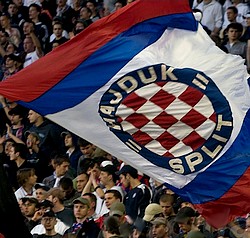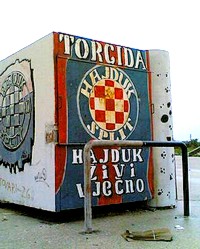The History of Hajduk Split
 In the beginning, Hajduk was the dreamy idea of four students studying in Prague who had a passion for football. Together, Fabijan Kaliterna, Ivan Šakić, Lucijan Stella, and Vjekoslav Ivanišević were inspired to start a team in Split, Croatia after watching matches between the teams of Sparta and Slavija. Hajduk was officially registered on February 13, 1911, and shortly after many locals of Split pitched in to begin construction of their new field. The first field was known as Kraljeva Njiva (King’s field), and it was constructed on what used to be training ground for the Austrian-Hungarian army. After several practice games and training, Hajduk’s very first game was played against an Italian team known as Calcio, and their first goal was scored by Sime Raunig, with his knee oddly enough.
In the beginning, Hajduk was the dreamy idea of four students studying in Prague who had a passion for football. Together, Fabijan Kaliterna, Ivan Šakić, Lucijan Stella, and Vjekoslav Ivanišević were inspired to start a team in Split, Croatia after watching matches between the teams of Sparta and Slavija. Hajduk was officially registered on February 13, 1911, and shortly after many locals of Split pitched in to begin construction of their new field. The first field was known as Kraljeva Njiva (King’s field), and it was constructed on what used to be training ground for the Austrian-Hungarian army. After several practice games and training, Hajduk’s very first game was played against an Italian team known as Calcio, and their first goal was scored by Sime Raunig, with his knee oddly enough.
After their founding, Hajduk quickly assumed a path of success, starting in 1923 when they played for the league of the Kingdom of Yugoslavia. Hajduk also toured North Africa in 1923, where they won their first international match with a score of three to two against Marseille. Soon thereafter, the entire Hajduk team excluding their Italian goalkeeper went on to play for the national team in 1924. This era in Hajduk history is often referred to as their first “glory period, seeing as how they won their very first championship title in 1927, and quickly followed it with their second in 1929. To celebrate their 20th anniversary, Hajduk went on a tour of the United States in 1931.
WWII and the 1940s
As World War Two overtook the world, Split was occupied by Italian forces, who offered Hajduk the opportunity to join the Italian first division, but the team defiantly refused. Instead, they played for the Yugoslav army against allied teams. The president of Yugoslavia, Josip Tito, was extremely impressed with the work of Hajduk and their playing abilities. His admiration lead to him offering Hajduk the chance to move to Belgrade and become a certified army team, however Hajduk declined and chose to remain in their home, Split.
In the year of 1946 Hajduk won the Croatian championship, and started a magazine known as “Hajdukov Vjesnik” (Hajduk Harold.) To conclude a decade, in 1949 Hajduk went on a tour of Australia, where they became the first Yugoslavian team to tour all continents, excluding Antarctica.
The Torcida
 By this point in time, Hajduk had developed a very devoted following of fans, and it was certainly time for them to identify themselves. The organization they formed was named Torcida, after the passionate Brazilian fans. On October 29, 1950 over 20,000 fans showed their support as Hajduk played Red Star. Unfortunately, there was government opposition to the organized support of the Torcida, and some members were imprisoned after the game for several years. This wouldn’t discourage Hajduk’s fans, but it did push their support to secrecy. In 1951, Hajduk had to reconstruct their stadium, Stari Plac. The year after, the team claimed its 6th championship title.
By this point in time, Hajduk had developed a very devoted following of fans, and it was certainly time for them to identify themselves. The organization they formed was named Torcida, after the passionate Brazilian fans. On October 29, 1950 over 20,000 fans showed their support as Hajduk played Red Star. Unfortunately, there was government opposition to the organized support of the Torcida, and some members were imprisoned after the game for several years. This wouldn’t discourage Hajduk’s fans, but it did push their support to secrecy. In 1951, Hajduk had to reconstruct their stadium, Stari Plac. The year after, the team claimed its 6th championship title.
For the next 14 years, Hajduk’s success was limited, but that would change in the 1966-67 season. During that particular season, Hajduk won the Yugoslav cup. This was also the first season that Hajduk played for the UEFA.
Zlatna Generacija
The 1970s began what has been nicknamed the “Zlatna Generacija”, or the golden generation of Hajduk. Between the years of 1972 and 1977, Hajduk won a very impressive 4 championships and 5 cups, in succession. This is an accomplishment that no other former-Yugoslav team has done. After this period of success, Hajduk was rewarded with a new stadium. The stadium was funded by the government, and with this funding the stadium was made very lavish, with some of the most impressive architecture of any football stadiums. There is a memorial tablet in the stadium for the Torcida who died or were imprisoned for their patriotism towards Croatian independence, something the Torcida advocated. The organization of the Torcida was officially reinstated in 1980. Although Hajduk was not quite as successful during the 1980s as in the previous decade, they did manage to win two national championships as well as making it to the semi-finals of the UEFA.
Modern Hajduk
Hajduk has continued to remain a very successful and prominent team within the recent 20 years. In 1991, Hajduk won the national cup. Even more impressive, in 1992 Hajduk won their 1st national championship at Poljud. This title is quite special to many Hajduk fans due to the fact that this was the first championship held in the independent Republic of Croatia. During the 1992-93 season, Hajduk won the Croatian Cup, and in the next season the champion title. In 1995, Hajduk’s winning streak magnified when they won the supercup, which they would also win in 2004 and 2005.
With a total of 17 championships, 13 cups, and 6 supercups it’s safe to say that Hajduk has solidified their team as one of the most talented in sports history, and their fans certainly have nothing to complain about.
Latest articles
-

The Infamous Stan Lee
May 30th, 2014 at 05:45pm
-

JJCC
March 25th, 2014 at 04:42am
-

GOT7
March 15th, 2014 at 11:26pm
-

Jung Joon Young
February 22nd, 2014 at 05:46am
-

2PM
January 12th, 2014 at 08:28am
